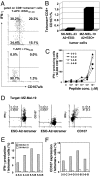Vaccination with an NY-ESO-1 peptide of HLA class I/II specificities induces integrated humoral and T cell responses in ovarian cancer
- PMID: 17652518
- PMCID: PMC1937553
- DOI: 10.1073/pnas.0703342104
Vaccination with an NY-ESO-1 peptide of HLA class I/II specificities induces integrated humoral and T cell responses in ovarian cancer
Abstract
NY-ESO-1 is a "cancer-testis" antigen expressed in epithelial ovarian cancer (EOC) and is among the most immunogenic tumor antigens defined to date. The NY-ESO-1 peptide epitope, ESO(157-170), is recognized by HLA-DP4-restricted CD4+ T cells and HLA-A2- and A24-restricted CD8+ T cells. To test whether providing cognate helper CD4+ T cells would enhance the antitumor immune response, we conducted a phase I clinical trial of immunization with ESO(157-170) mixed with incomplete Freund's adjuvant (Montanide ISA51) in 18 HLA-DP4+ EOC patients with minimal disease burden. NY-ESO-1-specific Ab responses and/or specific HLA-A2-restricted CD8+ and HLA-DP4-restricted CD4+ T cell responses were induced by a course of at least five vaccinations at three weekly intervals in a high proportion of patients. There were no serious vaccine-related adverse events. Vaccine-induced CD8+ and CD4+ T cell clones were shown to recognize NY-ESO-1-expressing tumor targets. T cell receptor analysis indicated that tumor-recognizing CD4+ T cell clones were structurally distinct from non-tumor-recognizing clones. Long-lived and functional vaccine-elicited CD8+ and CD4+ T cells were detectable in some patients up to 12 months after immunization. These results confirm the paradigm that the provision of cognate CD4+ T cell help is important for cancer vaccine design and provides the rationale for a phase II study design using ESO(157-170) epitope or the full-length NY-ESO-1 protein for immunotherapy in patients with EOC.
Conflict of interest statement
The authors declare no conflict of interest.
Figures






References
-
- Odunsi K, Jungbluth AA, Stockert E, Qian F, Gnjatic S, Tammela J, Intengan M, Beck A, Keitz B, Santiago D, et al. Cancer Res. 2003;63:6076–6083. - PubMed
Publication types
MeSH terms
Substances
LinkOut - more resources
Full Text Sources
Other Literature Sources
Medical
Research Materials

